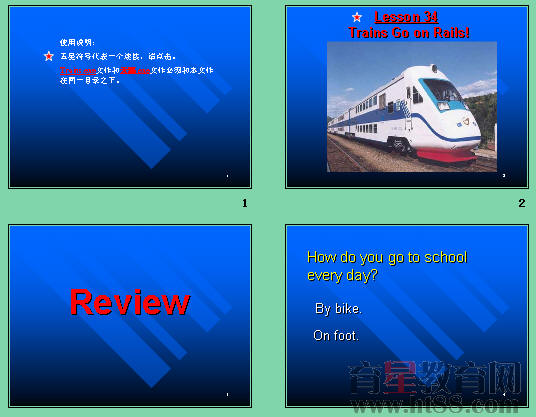《Trains Go on Rails!》ppt6
- 资源简介:

共32张。附教学设计。
教学设计
Book 4 34 Trains Go on Rails
陈红辉
给同学们播放一组西藏铁路的照片,配韩红的歌曲《天路》,使同学们将注意力尽快进入即将开始的学习。
复习:设计6个问题,让学生复习如何对旅行方式提问,并且复习交通工具以及重要词组by air/plane/taxi…
1. How do you go to school every day?
2. How do you travel to Beijing from Tangshan?
3. How do you go to Hangzhou from Suzhou?
4. How do you go to America?
5. What’s your favorite type of transportation?
6. In China, what’s the most important type of transportation when we travel to other cities?
导入:给同学们展示一组不同类型火车的照片,激发同学们了解火车知识的兴趣。
呈现本课课文中的重要词组:(检查预习情况,为课文理解扫除障碍;以抢答形式进行,激励大家积极参与;多次呈现,根据记忆规律,可以加深印象,使同学们当堂掌握。)
1. in the 1700s
2. the steam lootive
3. the passenger railway
4. the passenger train
5. early trains
6. today’s trains
7. trains of the future
8. the top speed
9. magnetic forces
10. jet engines
11. 380 kilometres an hour
12. high-speed trains
用所给单词的正确形式填空:
invent, discover, find
1. Who the steam engine?
2. bus America in 1492.
3. I him at home.
(通过练习使同学们正确理解这三个单词的区别——根据记忆规律,人们更容易记住在特定语境里的单词;而且通过对比(多重编码),记忆更牢靠。)
阅读课文,根据课文内容判断正误,如果是错误的,请加以改正。(检验同学们对课文的理解程度,为课文复述做好铺垫。)
1. A French scientist invented the steam lootive.
2. An Englishman drove the first steam lootive on a road.
3. The first railway was used in England.
4. People call the first passenger train Rocket.
5. Railway couldn’t be seen in most countries until late 19 century.
6. At the early time, the trains can run as fast as 50 kilometres per hour.
7. Now the trains can go 80 kilometres per minute.
8. People will see the train without wheels in the future.
根据关键词复述课文
1. 1700s/ work on the stream engine




资源评论
共有 1位用户发表了评论 查看完整内容我要评价此资源